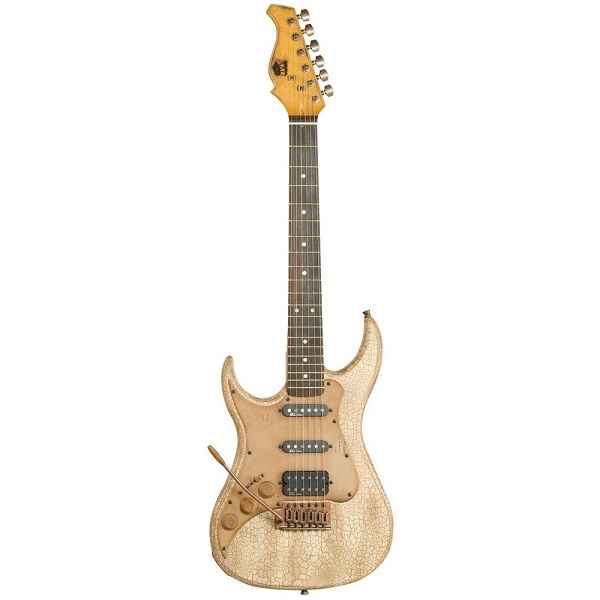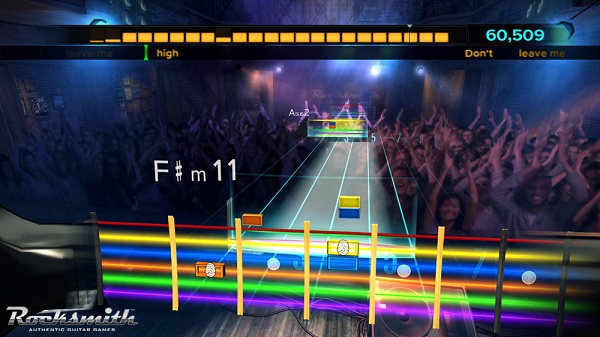|
Rocksmith
Available
on: PC, PS3 & Xbox 360 [tested]

Ubisoft is aiming to set the gaming world
on its collective ears, in this case their musical ears with the first
game that uses real guitars. Now the statement about the first game may
be true to an extent, as some may recall Rockband 3 had a pro guitar
mode, though with some limitations….for that one it had to be a special
guitar that supported MIDI.

EDWIN'S GUITAR
The Rock Gods mumbled and where placated
for a time, but something was missing, the Rock Gods wanted their people
to rock…
Now here comes Rocksmith from Ubisoft, throwing off the shackles of
limitations and banishing the plastic buttoned guitars as the false
offerings they are. Ubisoft designed Rocksmith to work with most any
electric style guitar you may have handy. I say most any guitar because
if you are going with an electric acoustic you will need a pickup for
the game to really hear the guitar well. The game ships with a Real Tone
USB cable which lets users plug a real electric guitar into a PS3, Xbox
360 or the Windows PC version which is scheduled for some time later in
2012. The electric guitar you use must have a 6.35mm (1/4” Jack) to play
the game. Or if you’re lucky to still find them, the game has a bundle
that comes with a sweet Epiphone Les Paul Junior Guitar. Get ready for
the Rocksmith journey, for those about to rock, we salute you.
I myself looked at several options for my first electric guitar, since I
was not only getting it to play the game. If it is your first electric
guitar there are some basic things you want to consider. First the
pickups on the guitar, these give you several options and tones that you
can play. This is the simplified explanation of course. When the strings
are played these induce a very small electric current in the magnetic
pickups, which are magnets wrapped with coils of very fine wire. That
current is then sent through a cable to a guitar amplifier, or in
Rocksmith’s case, your gaming system. Magnetic pickups tend to pick up
ambient and unwanted electromagnetic noises.
Single coil pickups tend to pick up stronger hum. Some models are more
bothersome than others. Though, with some adjustments to the controls,
the hum should not be a problem. Rather than a three single coil pickup
configuration, I went with a two single coil pickups and something
called a humbucker. A humbucker pickup reduces the unwanted humming
sound. Humbuckers have two coils of opposite magnetic and electric
polarity. This means that electromagnetic noise hitting both coils
should cancel itself out. The two coils are wired in phase, so the
signal picked up by each coil is added together. This high combined
inductance of the two coils leads to the richer, "fatter" tone
associated with humbucking pickups.
For my jump in to the world of Rocksmith I chose an AXL Badwater ¾ size
guitar. I went with this one because it was a little compact; you may
want to go with a full size guitar depending on your needs.
These models have some attitude, designed with a distressed body and
antiqued hardware with EMG-designed pickups. The sound is good and
clean.
One other suggestion here, while it could be fun to stand up and play, I
would suggest sitting while learning for the first time, with the
instrument resting on one leg.
So on I went, loaded up the review copy the folks had sent over from
Ubisoft, which by the way…it is always a good sign when folks associated
with a product come across as proud parents. It tells me they love what
they do, and what they put into a product. Well after things loaded up,
I plugged the Real tone USB cable into the guitar.

Very first impressions as the game asked a
few questions to get things set up; Rocksmith right away had the
trappings of a very patient tutor or guide on guitar. The game asks you
about the guitar configuration you have, and much to my relief, if you
are playing right or left handed. YES, we left hand players can learn to
rock too. After that the game went to something called sound check, it
just wanted me to make some noise and fill up a noise meter as the
virtual crowd roared their approval. With pick in hand I strummed away,
at this point it did not need to sound coherent; it was just looking for
sound levels. I learned two things…on my own during sound check. First
and this was a theme I found throughout the games offerings, you have to
sometimes play over the pickup you have activated on the guitar for the
game to really pick up the sound.
Second thing I learned at sound check, I could not keep the sound going
long enough to fill the meter, and so I was stuck for a time in sound
check mode. What to do? I went ahead and fingered the strings instead of
using the pick, as a result I was able to play fast enough and load
enough for the sound meter to fill up and for the game to proceed past
this section.
So far so good, the whole experience is not necessarily a guitar
teacher, more along the lines of a couching tool. Can you learn things
about the guitar and how to play? Yes, but as with anything worthwhile,
you are the vital ingredient. No program, no matter how good it’s
approach; will be able to teach you anything unless you have a little
dedication and put the time into it. Without any interest, a person can
lose interest and not even bother. Only if the game keeps a level of
interest, and in turn put the gameplay and practice in, will the player
succeed. Rocksmith succeeds as being a truly awesome game, and can be
used as a tool for learning guitar because of the aspect of using real
guitars.
The game itself puts the player through a form of a career mode, more
like a musician’s journey. A journey both in game and in reality really,
because it’s a journey of learning techniques, tuning, and guitar in
general. It simulates an amateur musician’s hopeful rise, from practice,
to small venues and small set lists and then onto larger arenas and
sets. When do you know you’re ready? The player practices and rehearses
till they get a certain point and percentage score, then they are ready
to move on to the show. While going on this musical journey, the game
often makes suggestions as to what to practice, be it notes or chords in
hopes of bringing up your actual skill level.
Bee bopping along in the game modes I was a little bummed that not all
of the input seemed to register all the time. So the game would once in
a while not acknowledge I did a note, even if I did. This did not take
place a lot, but it was enough to make me wonder what the heck was going
on. It is unknown as to if this is actually the game, or user error. Is
the game that demanding that the way you do the note is exact? It may
well be. And that may well be a good thing. Did I get a short blast of
frustration? Yes. Did that go away almost right away when I hit certain
notes or strums it asked me to do? You bet. It felt great.
Now there is also a game manual that you can get the low down about the
game parts but nothing in depth. Most of the symbols and the way notes
are presented and what the game wants you to do are only explained IN
GAME, during a practice or technique learning section. So someone just
coming into this may or may not feel that the game lay out is intuitive
enough for them to know what to do. I kind of figured several things out
that it wanted me to do during game play. One was even while hitting the
note and the fret it wants you to hit, once in a while there would be an
arrow symbol asking me to …what I was guessing, was to move up or down
the fret I was on, moving a bit up on the same fret seemed to give the
game what it wanted and things progressed.
As you are playing, the screen lay out from top to bottom goes like
this. At the top is the Phrase Line, here in this area you will see the
song’s position and the lyrics to the song. At the top right is a
display for the points accumulated. Around the middle of the screen is
the note way… think of this like a freeway that the notes it’s going to
want you to play are coming at you towards the fret board.
Further things that I want to draw attention to, is that the game has a
color system for the strings, not the actual string names of
(E-B-G-D-A-E). Even for a beginner, this may take some getting used to.
I would suggest on top of the games color system, that you also learn
the strings actual letter designation as well.
During play the camera kind of refocuses from time to time, moving up
and down the neck of the virtual guitar, focusing on the frets where the
next notes are coming. The strings with an upcoming note are
highlighted, and the box on the string and fret start to grow in
outline, just moments before it is time to play that note the slotted
outlined box will turn and go solid, that is the moment to play the
note.

Now when you’re first starting out, you do
not have to worry about a hurricane of notes bombarding you, not yet
anyway. The game has what it calls a dynamic difficulty system. The game
itself can tell how well or how badly you’re doing, and adjust itself to
your level, you may start out just hitting one note at a time and this
may progress as you are hitting more notes up and down the guitar neck
successfully. Until eventually you are playing along with the song, how
thrilling is that? Very.
Some parts of the games adaptive scaling to the skill of the player
takes place in things like riff Repeater. It takes tougher sections of a
song and slows things way down for you and starts building up the speed
till it’s at the normal song speed.
Part of music’s coolness and some of our favorite songs and guitar
players signature sounds comes from their amp configurations. In
Rocksmith, there is an Amp screen where you can access unlocked amps and
pedals or make some of your own unique sounds. The Amp Menu allows
players to customize sound settings. Setting up the amplifier and
effects chain in certain ways, also as the player goes through the game
they will unlock Authentic Tone setups and effects, amps and cabinets.
Using these together is how you, the player can make your own unique
sounds as well. This is also where the controller becomes a pedal of
sorts for your sounds. You can have a maximum of three unique pedals in
a tone, plus an amp and cabinet. Each of these tone slots can be
assigned to one of the X, Y or B buttons on the controller. Pressing any
of these while playing a song will change to that tone.
All in all the game is incredible so far, it sneaks in learning about
what chords and notes and frets to play and turns it into a game, making
practice much more fun than it would have been. It of course does not
stop there.
There are several mini games within Rocksmith. This Guitarcade, features
old school style games with a guitar twist. Each game in is based on a
key guitar technique, helping the player improve skills with the game
challenges.
Ducks is a game that helps improve your fret board reflexes and shoot
down ducks scrolling up the note way. Play the matching fret on the E
string (the thickest string) based on each duck’s location. String
together consecutive hits for a score multiplier!
Super Ducks is the game that really tests you; this is like Ducks but
with much more. Play the matching fret and string based on each duck’s
location and color. String together consecutive hits to unlock the next
level. Let a duck get through, and you lose one life.
Scale Runner is the next game, in this one the player selects a scale
and key, and then plays the note that is shown by the next runway. The
runner speeds up as the player hits the right notes. To avoid pitfalls
and falling off the platform you have to hit the next note in the scale
in time.
Quick Pick Dash is the game that has the player play the highlighted
open string that an ostrich is running along. But play it as fast as
possible. Switching strings to jump to different tracks and collecting
points to extend the countdown clock.
Big Swing Baseball as you would expect by the name has a baseball theme.
Players have to play the note indicated by the fret number and the color
thrown by the pitcher. Timing the swing for the most power, the pitcher
can also throw curve balls which require bending the note.
Super Slider, is kind of a Tetris like game. Blocks of differing colors
drop from the top of a grid, playing the indicated string at the block’s
fret number and sliding up or down to move the blocks position is how
it’s played. Then strumming all the strings to drop the block right
away, the goal is to match colors for the most points.

Dawn of the Chorded is a game where just
when you thought you could get into a game that had no reference to
zombies, it sneaks it in. Playing the indicated chord activates defenses
before the zombies close in and it’s all over.
Harmonically Challenged, finds the player trying to play the right
harmonics to disarm a bomb. Strings and fret numbers display before the
bomb initiates, playing the harmonics in the correct order renders the
bomb safe.
The game hidden within a game hidden in guitar introduction trainer that
rocks. That’s Rocksmith. Right out of the box, it comes with a robust
song list. To keep the fans interested, the company will have to see
about DLC and they in fact have been very forward thinking about DLC
since the games release.
So far the franchise has some fairly aggressive Downloadable content
plans; with new songs for the game coming out roughly about every two
weeks so far. The DLC thus far has been a large cross section of very
well known to, known bands and songs. At this time the forums for
Rocksmith have an extremely lively board with DLC suggestions. Some of
us at Impulse Gamer hope they will do more band specific packs, maybe
some of the greats Like Styx, Hall and Oates to name just a couple. At
this time there are several songs released as DLC and song packs. Make
sure you do not double purchase; some song packs have some of the single
song offers.
Worldwide readers will be able to rock out very soon as the game will be
releasing locally in Europe, the Middle East, Asia, Australia and New
Zealand sometime in a few months, you can pick the game up and or pre
order from Amazon, and other outlets.
Rocksmith has set the next standard in music gaming, it’s hard to
envision bothering with fake push button guitars ever again really.
Again, you still have to have that stick to it attitude to get anyplace
here, but it’s a spectacular jump off point for beginners and a blast
once you really get going.
Have fun, play games…. Rock On!
Edwin Millheim
Impulse Gamer
|